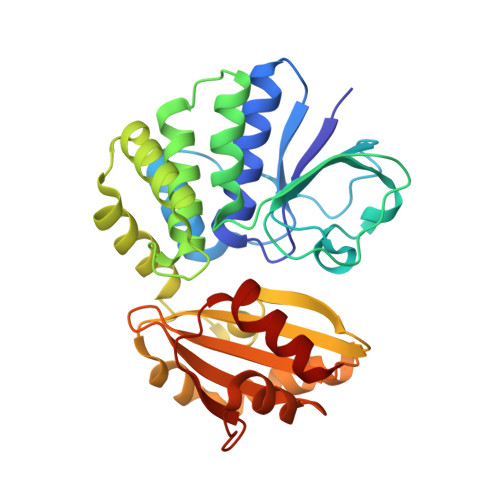A Trimetal Site and Substrate Distortion in a Family II Inorganic Pyrophosphatase.
Fabrichniy, I.P., Lehtio, L., Tammenkoski, M., Zyryanov, A.B., Oksanen, E., Baykov, A.A., Lahti, R., Goldman, A.(2007) J Biological Chem 282: 1422
- PubMed: 17095506
- DOI: https://doi.org/10.1074/jbc.M513161200
- Primary Citation of Related Structures:
2HAW, 2IW4 - PubMed Abstract:
We report the first crystal structures of a family II pyrophosphatase complexed with a substrate analogue, imidodiphosphate (PNP). These provide new insights into the catalytic reaction mechanism of this enzyme family. We were able to capture the substrate complex both by fluoride inhibition and by site-directed mutagenesis providing complementary snapshots of the Michaelis complex. Structures of both the fluoride-inhibited wild type and the H98Q variant of the PNP-Bacillus subtilis pyrophosphatase complex show a unique trinuclear metal center. Each metal ion coordinates a terminal oxygen on the electrophilic phosphate and a lone pair on the putative nucleophile, thus placing it in line with the scissile bond without any coordination by protein. The nucleophile moves further away from the electrophilic phosphorus site, to the opposite side of the trimetal plane, upon binding of substrate. In comparison with earlier product complexes, the side chain of Lys296 has swung in and so three positively charged side chains, His98, Lys205 and Lys296, now surround the bridging nitrogen in PNP. Finally, one of the active sites in the wild-type structure appears to show evidence of substrate distortion. Binding to the enzyme may thus strain the substrate and thus enhance the catalytic rate.
- Program in Structural Biology and Biophysics, Institute of Biotechnology, University of Helsinki, Biocenter 3, P. O. Box 65, FIN-00014 Helsinki, Finland.
Organizational Affiliation:























